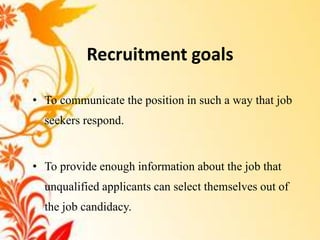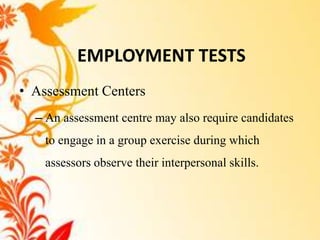Recruitment sources in hrp
- 1. HUMA N RESOURCE PLANNING:- M.HIMA BINDU
- 2. Contents: • Unit-3: 1. Recruitment 2. Sources 3. Evaluation and selection procedures, techniques 4. Factors influencing recruitment & selection 5. Placement 6. Induction 7. Training 8. Strategies for orienting new employees
- 3. RECRUITMENT PROCESS DEFINATION • The process of discovering potential job candidates.
- 4. Recruitment goals • To communicate the position in such a way that job seekers respond. • To provide enough information about the job that unqualified applicants can select themselves out of the job candidacy.
- 5. RECRUITMENT SOURCES • The Internal Sources • The External Sources
- 6. INTERNAL SOURCES • Employees Referrals/Recommendations A recommendation from a current employee regarding a job applicant
- 7. WHY PREFER INTERNAL SOURCES • It builds good public relations. • It builds morale. • It encourages good individuals who are ambitious. • It is less costly.
- 8. WHY PREFER INTERNAL SOURCES • Those chosen internally already know the organization. • It improves the probability of a good selection, since information on the individual‟s performance is readily available.
- 9. THE EXTERNAL SOURCES – Advertising – Employment Agencies – School, Colleges and Universities – Professional Organizations – Unsolicited Applicants
- 10. RECRUITMENT ALTERNATIVES • Temporary Help Services • Employee Leasing • Independent Contractors
- 11. THE SELECTION PROCESS Initial screening Application form Employment Tests Background Short listing Interviewing Investigations Permanent Job Conditional Job Medical Fitness Offer offer Consideration for Disables
- 12. EMPLOYMENT TESTS • Performance Simulation Tests – Focus on actual job activities • Work Sampling – To actually perform a small segment of the job
- 13. EMPLOYMENT TESTS • Presentations – to assess the qualities of candidates applying for posts which require a complex set of skills, together with specific professional/academic knowledge.
- 14. EMPLOYMENT TESTS • Case Studies – used for candidates for managerial posts, or for posts requiring knowledge of specific procedures, regulations or legislation.
- 15. EMPLOYMENT TESTS • Group Selection Methods – Leaderless group discussions; – Command or executive exercises (e.g. outward bound); – Group problem solving.
- 16. EMPLOYMENT TESTS • Assessment Centers – An assessment centre may also require candidates to engage in a group exercise during which assessors observe their interpersonal skills.
- 17. EMPLOYMENT TESTS • Psychometric Tests – Tests of ability, aptitude or intelligence; – Questionnaires to measure "personality"; – Questionnaires to establish interests and preferences.
- 18. INTERVIEWING The purpose of a selection interview is to: • Collect evidence against the person specification in order to predict how successfully the candidate would perform in the job. • Help promote a positive image of the University. • Enable the panel to make the best use of available time in reaching a decision.
- 19. INTERVIEWING • Give candidates information about the job to facilitate their decision making. • Research shows that structured interviews are significantly more likely to serve this dual purpose and lead to successful appointments. A structured interview will also: • Ensure consistency throughout the interviews
- 20. INTERWIEING FAULTS Do remember that the interview has limitations and risks. Here are some common ways by which it can be flawed. ● Inadequate preparation.
- 21. INTERWIEING FAULTS ● A subjective process where judgement may be base on first impression. ● The panel may not be consistent in their treatment of different applicants
- 22. INTERWIEING FAULTS • The skills tested may be only those of self- presentation, which may be irrelevant or form only a minor part of the skills needed for the job.
- 23. HOW TO IMPROVE Once these shortcomings are clear, steps can be taken to overcome them: • consistent, well-understood recruitment procedures. • the interview may be backed up by a practical exercise or test.
- 24. HOW TO IMPROVE • Interviewers can also improve their own effectiveness by careful planning. • Interviewers and those involved in short-listing can being completely familiar with the job description and selection criteria
- 25. HOW TO IMPROVE • Interviewers can reflect on the good and bad aspects of interviews they have attended. • Interviewers can themselves more aware of factors that cloud their own perceptions and judgement so that they can overcome them.
- 26. HOW TO IMPROVE • Interviewers can ignore irrelevancies and ask themselves repeatedly whether something they‟ve observed about a particular candidate is directly relevant to the person specification and selection criteria.
- 27. INDUCTION: • INTRODUCTION:- After an new employee is hired in the organization, it is necessary he or she be familiar to organization philosophies, goals & objectives, policies, procedures, rules & regulations & practices. This orientation is called employee induction.
- 28. Induction:- • Definition:- Induction can be defined as, “the HRM function that systematically & formally introduces new employees to organization, jobs , the work groups to which they will belong & work environment where they will work”.
- 29. Induction:- • Objectives:- To introduce new employees with the organizational environment. To create positive attitude in the minds of the new employees. Help the new employee overcome shyness & nervousness in meeting new people in new environment.
- 30. Objectives:- Helps in reducing labour turnover. Develop among new employees a sense of belongingness & loyalty to organization.
- 31. Induction program:- • Steps in induction program:- An induction program essentially involves the following steps; A. General orientation B. Specific orientation C. Follow-up orientation
- 32. Induction program:- • General orientation:- 1. It includes guidance tours in different departments of an organization. 2. Some organizations have their printed manuals. 3. The purpose of general orientation program is to build a sense of pride, and also create interest in them about the organization.
- 33. Induction program:- • Specific orientation:- 1. The purpose of specific orientation is to help new employees to get acclimatized with their new work environment. 2. For executives and managerial employees, targets and key result areas for each of them are given to make them aware of what organization expects from them,
- 34. Induction program:- • Follow-up orientation:- 1. The follow-up orientation is conducted sometime after the initial induction of an employee, i.e., preferably within a period of 6 months. 2. The purpose of such orientation is to give guidance and counsel to employees to ensure that they are reasonably satisfied.
- 35. Employee socialization:- • Employee orientation and induction is also called employee socialization. • Robbins identified that socialization process involves three distinct stages; 1. Pre-arrival stage 2. Encounter stage 3. Metamorphosis stage
- 36. Stages in employee socialization Socialization is a continuous process, today's organizations being dynamic. • Pre-arrival stage:- At this stage individual employees come to an organization with certain values , attitudes and expectations.
- 37. Stages in employee socialization • Encounter stage:- At this stage , perceptions earlier generated by an individual, are reaffirmed through a well planned induction program
- 38. Stages in employee socialization • Metamorphosis stage:- At this final stage of socialization, employees understand the organizations and identify then with the organizations. TO keep pace with the changing environment, the organizations are following socialization process which is continuous process.
- 39. Advantages:- • Builds two way communication channel. • Improves relations and team work among employees. • To integrate new employees into organization & to develop a sense of belongingness. • Reduces employee grievances, labour turnover.
- 40. PLACEMENT:- • INTRODUCTION:- • Placement is a process of assigning a specific job to each of the selected candidates. • It involves assigning a specific job and responsibility to an individual. • It involves matching the requirements of a job with qualifications of candidates.
- 41. Placement:- • After an induction program is over an employee is put to a specific job for which he has been selected. • Most of the organizations put new employees on probation for a specific period.
- 42. Placement:- • Some organizations also have a system to extend the probationary period, if the employees fail to match to organization expectations. Such placement is known as „differential placement.”
- 43. Placement:- • Significance: 1. It improves employee morale. 2. It helps in reducing employee turnover. 3. It helps in reducing absenteeism. 4. It helps the candidates to work as per predetermined objectives of organization.
- 44. Training: • Increasing knowledge and skills for doing a particular job; it bridges the gap between job needs and employee skills, knowledge and behavior. • Focuses attention on the current job; it is job specific and address particular performance deficits/ problems.
- 45. Training: • Concentrates on individual employees; changing what employees know, how they work, their attitudes toward their work or their interactions. • Tends to be more narrowly focused and oriented towards short term performance concerns.
- 46. Types of training: • Skill training • Reference training • Cross-functional training • Team training • Creativity training • Diversity training • Literacy training
- 47. The Training Process • Training – The process of teaching new employees the basic skills they need to perform their jobs. © 2005 Prentice Hall Inc. All 8–47 rights reserved.
- 48. The Training Process • The strategic context of training – Performance management: the process employers use to make sure employees are working toward organizational goals. • Web-based training • Distance learning-based training • Cross-cultural diversity training
- 49. The Training and Development Process • Needs analysis – Identify job performance skills needed, assess prospective trainees skills, and develop objectives. • Instructional design – Produce the training program content, including workbooks, exercises, and activities. © 2005 Prentice Hall Inc. All 8–49 rights reserved.
- 50. The Training and Development Process • Needs analysis – Identify job performance skills needed, assess prospective trainees skills, and develop objectives. • Instructional design – Produce the training program content, including workbooks, exercises, and activities.
- 51. Training Methods • On-the-job training (OJT) – Having a person learn a job by actually doing the job. • OJT methods – Coaching or understudy – Job rotation – Special assignments © 2005 Prentice Hall Inc. All 8–51 rights reserved.
- 52. Training Methods • Advantages – Inexpensive – Immediate feedback
- 53. Strategies for Orienting Employees • Employee orientation – A procedure for providing new employees with basic background information about the firm. © 2005 Prentice Hall Inc. All 8–53 rights reserved.
- 54. Strategies for Orienting Employees • Orientation content – Information on employee benefits – Personnel policies – The daily routine – Company organization and operations – Safety measures and regulations – Facilities tour
- 55. Orienting Employees (cont’d) • A successful orientation should accomplish four things for new employees: – Make them feel welcome and at ease. – Help them understand the organization in a broad sense. © 2005 Prentice Hall Inc. All 8–55 rights reserved.
- 56. Orienting Employees (cont’d) – Help them begin the process of becoming socialized into the firm‟s ways of acting and doing things. – Make clear to them what is expected in terms of work and behavior.























































